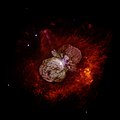ไฟล์:Eta Carinae.jpg

ขนาดของตัวอย่างนี้: 600 × 599 พิกเซล ความละเอียดอื่น: 240 × 240 พิกเซล | 480 × 480 พิกเซล | 769 × 768 พิกเซล | 1,025 × 1,024 พิกเซล | 2,015 × 2,013 พิกเซล
ไฟล์ต้นฉบับ (2,015 × 2,013 พิกเซล, ขนาดไฟล์: 163 กิโลไบต์, ชนิดไมม์: image/jpeg)
ประวัติไฟล์
คลิกวันที่/เวลาเพื่อดูไฟล์ที่ปรากฏในขณะนั้น
| วันที่/เวลา | รูปย่อ | ขนาด | ผู้ใช้ | ความเห็น | |
|---|---|---|---|---|---|
| ปัจจุบัน | 16:41, 18 ธันวาคม 2560 |  | 2,015 × 2,013 (163 กิโลไบต์) | The NMI User | Reverted to version as of 14:14, 1 May 2008 (UTC) |
| 21:45, 13 มีนาคม 2560 |  | 3,000 × 2,998 (1.18 เมกะไบต์) | Leogorgon | larger file size | |
| 21:14, 1 พฤษภาคม 2551 |  | 2,015 × 2,013 (163 กิโลไบต์) | Vol de nuit | {{Information |Description=(NASA News Release) A huge, billowing pair of gas and dust clouds are captured in this stunning NASA Hubble Space Telescope image of the supermassive star Eta Carinae. Using a combination of image processing techniques (ditheri |
การใช้ไฟล์
ไม่มีหน้าที่ใช้ไฟล์นี้
การใช้ไฟล์ข้ามโครงการ
วิกิอื่นต่อไปนี้ใช้ไฟล์นี้:
- การใช้บน da.wikipedia.org
- การใช้บน en.wikipedia.org
- Star
- Eta Carinae
- Wikipedia:Selected anniversaries/March 11
- Wikipedia:Today's featured article/March 2017
- Wikipedia:WikiProject Wikipack Africa Content/Wikipedia:Showcase
- Wikipedia:WikiProject WikiFundi Content/Eta Carinae
- Wikipedia:Today's featured article/requests/Eta Carinae
- Wikipedia:Today's featured article/March 12, 2017
- Wikipedia:Main Page history/2017 March 12
- Wikipedia:WikiProject WikiFundi Content/Wikipedia:Showcase
- Wikipedia:Main Page history/2022 March 11
- Wikipedia:Main Page history/2022 March 11b
- Wikipedia:Main Page history/2023 March 11
- Wikipedia:Main Page history/2023 March 11b
- User:2003 LN6/sandbox/Eta Carinae variable
- List of luminous blue variable stars
- การใช้บน en.wikiversity.org
- User:Marshallsumter/Radiation astronomy2/Visuals
- User:Marshallsumter/Radiation astronomy2/Violets
- Stars/Astronomy
- User:Marshallsumter/Radiation astronomy2/Violets/Quiz
- Stars/Sun/Astronomy/Quiz
- User:Marshallsumter/Radiation astronomy/Courses/Principles/Hourly 2
- User:Marshallsumter/Radiation astronomy/Courses/Principles/Final quiz
- Draft:Original research/Io/Quiz
- Titan/Quiz
- Stars/Solar systems/Quiz
- Moon/Quiz
- Earth/Quiz
- User:Marshallsumter/Radiation astronomy/Colors/Quiz
- Volcanoes/Io/Quiz
- Stars/Violets
- User:Marshallsumter/Radiation astronomy2/Stars
- Stars/Violets/Quiz
- การใช้บน es.wikipedia.org
- การใช้บน fr.wikipedia.org
- การใช้บน hi.wikipedia.org
- การใช้บน it.wikibooks.org
- การใช้บน la.wikipedia.org
- การใช้บน mk.wikipedia.org
- การใช้บน ms.wikipedia.org
- การใช้บน my.wikipedia.org
- การใช้บน oc.wikipedia.org
- การใช้บน ru.wikipedia.org
- การใช้บน sk.wikipedia.org
- การใช้บน sr.wikipedia.org
- การใช้บน th.wikipedia.org
ดูการใช้ข้ามโครงการเพิ่มเติมของไฟล์นี้
